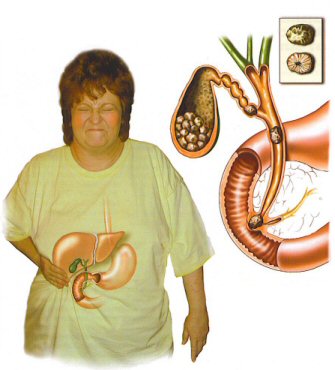Big C Discount Drugs Health Information
Gallstones

Bile Can Harden to Form Stones
Each year, about one million new cases of gallstones are diagnosed in the United States. Half of these patients undergo surgery, known as choltcystectomy, to remove their gallbladder.
Gallstones Affect Millions of Americans
Gallstones are a relatively common condition affecting 10% to 15% of Americans. More men than women are stricken, and there are verv high rates in Native Americans and Mexican-Americans. Obesity, age, a high-fat/low-fiber diet, crash diets or periods of fasting, and a family history of gallstones all increase the risk of gallstone formation. Estrogen levels are also linked with gallstones, since the stones form more often in women who are pregnant or who take birth conttol pills or hormone replacement medication. Both obesity and high estrogen levels can cause slower gallbladder emptying. High estrogen levels may lead to increased cholesterol levels in the bile, which is also true for people who take cholesterol-lowering drugs, since these medications increase the amount of cholesterol secreted in bile. People with diabetes often have high triglyceride levels, which can increase the risk of forming gallstones.Symptoms Don't Always Appear: Many people with gallstones do not have any symptoms. Gallstones are often discovered when patients undergo testing for other conditions. In most cases, these patients do not need treatment. Symptomatic gallstones can cause sharp pain that may slowly worsen and then slowly improve over several hours. The pain from gallstones most often is felt on the right side of the upper abdomen. It can also shoot up to just below the right shoulder blade. Often the pain is associated with nausea or vomiting. In some patients, often after a high-fat meal, bloating, gas, and an uncomfortable feeling of fullness are present.
The diagnosis of gallstones is made after a history of symptoms is taken, along with blood tests. X-ray tests and abdominal ultrasound screenings are also helpful. The oral cholecystogram, or OCG test, is specific for gallbladder disease. In this test, oral dye is swallowed so the gallbladder can be seen on x-ray. These tests are useful if the gallstones are still in the gallbladder. If gallstones have moved into the common bile duct, other specialized tests must be used to see the stones on x-ray.
Medications: In some patients with small cholesterol gallstones, oral medications (either ursodiol or chenodiol) can be used to dissolve the gallstones. These drugs, which must be used for months and even years, can cause diarrhea. Patients who have only one or two larger cholesterol gallstones can be treated with lithotripsy, a sound wave technique that disintegrates the stones in the gallbladder The tiny pieces of gallstones then must be dissolved with medications. A chemical called methyl terbutyl ether can be injected into the gallbladder to dissolve the stones, but this method has had complications reported with its use. In up to half of all patients treated with nonsurgical methods, gallstones return after treatment. The other treatment option is surgery, either by open surgery or laparoscopy. In the US today, the vast majority of gallbladder surgery is laparoscopic cholecystectomy: A tiny camera and small instruments are inserted into the abdominal cavity through several small slits, avoiding an incision into the abdominal muscles. It means typically only one night in the hospital, a much quicker recovery and less pain, and no large and unsightly scars. Open cholecystectomy is safe but requires a 5- to 8-inch cut through abdominal muscle tissue. Naturally, this major surgery requires a longer hospital stay (five to seven days) and recovery is slower. Since the gallbladder is not a vital organ, there are usually no problems after it is removed, and for most patients, there are no resulting dietary restrictions. In a very small percentage of people, diarrhea can occur, since bile is no longer stored in the gallbladder but flows directly from the liver through the common bile duct into the small intestine.
